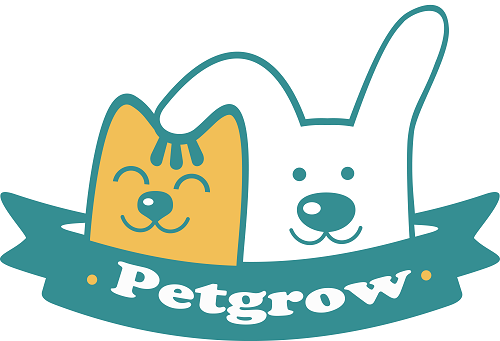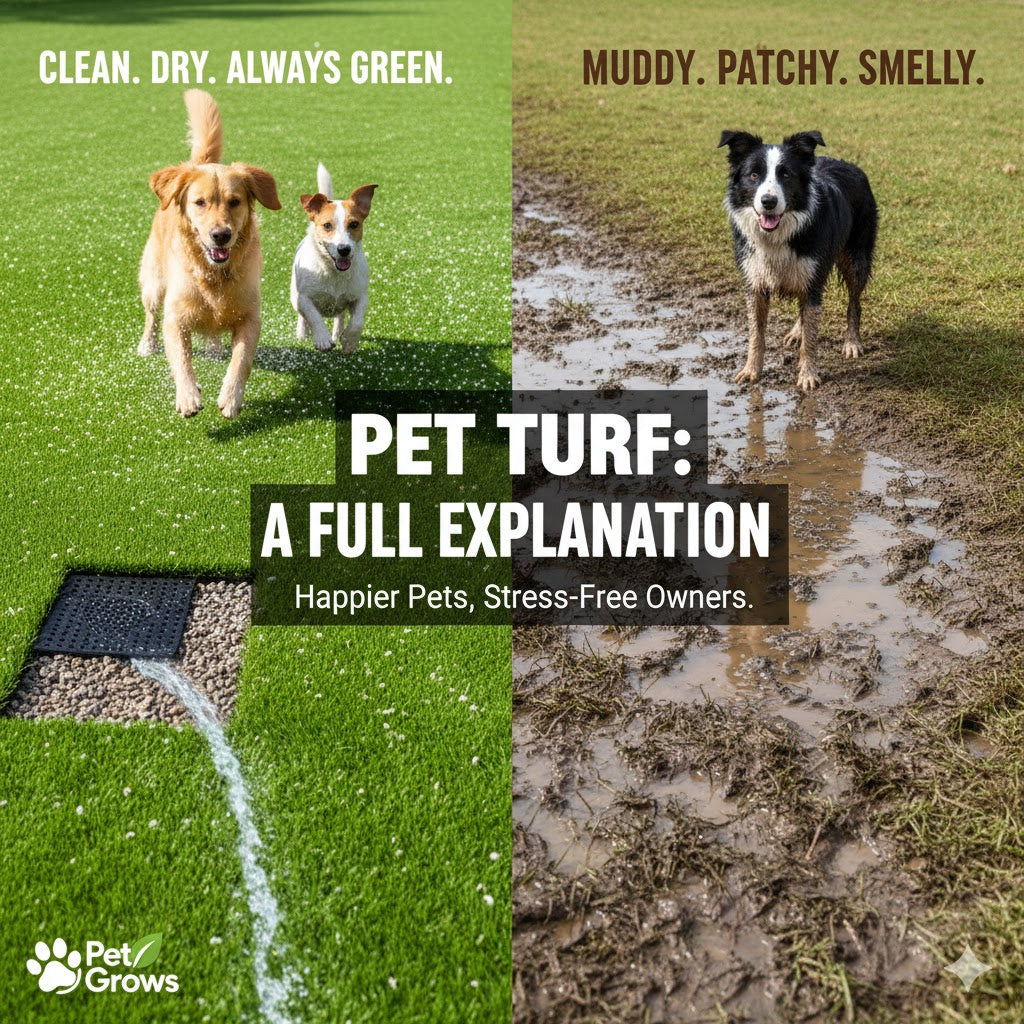For many dog owners, pet turf is the simple fix for messy yards and constant cleanup. It gives pets a safe, clean space to run and play without mud or smells. Natural grass wears down fast and turns brown, but pet turf stays green through heavy use and bad weather. It drains quickly, feels soft under paws, and cleans easily with a quick rinse.
There’s no mowing, watering, or fertilizer needed. You save time, money, and effort while keeping your yard fresh all year. Pet turf also keeps your home cleaner by stopping muddy paw prints and reducing odors after rain. It’s comfortable and convenient on one surface.
What Is Pet Turf and How Does It Work?
Pet turf is a type of artificial grass made especially for dogs. It looks like real grass but uses strong synthetic fibers that hold up to digging, running, and rough play. The main idea is simple: it gives dogs a clean, soft, and safe place to play every day.
Under the turf is a special drainage system that moves water and pet urine quickly through the surface. This keeps the yard dry and free from bad smells. The turf also uses an infill material that helps blades stand tall and stay cool under sunlight.
Why Pet Turf Is Better Than Natural Grass
Pet turf solves problems that natural grass can’t. Real lawns turn muddy, grow uneven, and need constant care. Dogs dig holes, leave bare spots, and make cleanup hard after rain. With pet turf, you skip all that work and still keep a green yard.
No Mud, No Mess
Pet turf doesn’t get muddy. Its drainage layer moves water away fast, so your dog can play right after rain. No more paw prints on the floor or patchy grass outside.
Cleaner and Odor-Free
Good pet turf drains pet urine quickly. It stops bacteria from growing and keeps your yard smelling fresh. A quick rinse is usually enough to clean it.
Durable and Safe
Pet turf uses non-toxic synthetic grass fibers that are gentle on paws and tough against digging. It doesn’t need weed killer or fertilizer, so it’s safe for every furry friend.

Components of a Quality Pet Turf System
A strong pet turf system includes several layers that work together to create a safe, durable play area for dogs. Each layer supports drainage, comfort, and long-term use.
Turf Fibers and Pile Height
The top layer of pet turf uses durable turf fibers that look and feel like real grass. A pile height of about one inch works best. It’s soft for paws and easy to clean. The face weight adds strength and helps the turf hold up under heavy play and running.
Backing and Drainage Layer
Under the turf lies the drainage layer, the most important part of a pet turf system. A fully permeable drainage system allows water and pet urine to flow through quickly. This prevents odor, bacteria growth, and soggy spots. For better flow, some installers use Drain Core panels or a French drain under the turf.
Infill Material
Infill sits between the turf blades and supports them. It keeps the surface springy and odor-free. The best infill for pet turf is antibacterial sand infill or zeolite. These materials fight smell, add softness, and help cool the turf during hot days.
Weed Barrier and Base
A compacted crushed rock base holds everything steady and drains fast. Some yards include a weed barrier, but skipping it can improve airflow and reduce bacteria buildup. Together, these layers make a clean, lasting surface for pets to enjoy.
How Pet Turf Is Installed
Installing turf takes careful steps to make sure it drains well and lasts for years. Each stage matters for comfort, safety, and durability.
Step 1: Prepare the Ground
Start by removing any old living grass, weeds, or concrete flooring. The surface should be clean and level before adding new layers.
Step 2: Build the Base
Spread 3 to 4 inches of crushed rock or decomposed granite to create a solid foundation. Compact it well so the turf won’t shift. This layer also helps water drain quickly through the pet turf system.
Step 3: Add a Drainage Layer
Some installations include Drain Core panels or small perforated pipes for better flow. This step keeps urine and rain from pooling under the turf.
Step 4: Lay the Turf
Unroll the pet turf in the same direction, usually in 15 ft. rolls. Trim the edges neatly. Line up seams so they blend naturally.
Step 5: Secure the Turf
Use turf nails or adhesive to keep edges tight and flat. Make sure there are no gaps where water can collect.
Step 6: Add Infill and Brush the Fibers
Spread the chosen infill material evenly using a drop spreader. Then brush the turf with a power broom to lift the blades and spread the infill evenly.
Step 7: Final Check
Walk the area, rinse it once, and check that water drains smoothly. Proper turf installation ensures your pet turf stays strong, clean, and comfortable for years.

Maintenance Tips for Long-Lasting Pet Turf
Caring for pet turf is simple, but it needs steady attention to stay clean and fresh. A few small habits will keep it looking great for years.
Regular Cleaning Routine
Pick up pet waste every day to avoid smells. Rinse the turf with a hose once or twice a week, especially in dry weather. For pet urine areas, spray with a mild vinegar mix or an enzyme cleaner. This removes residue and keeps bacteria away.
Seasonal Care
Every few months, brush the turf with a power broom to lift flattened blades and spread the infill material evenly. Check for low spots or thin infill and add more when needed. If you use zeolite or antibacterial sand infill, refresh it once or twice a year to maintain odor control.
Preventing Heat and Damage
Most modern turf includes UV protection to stop fading, but you can also rinse it on hot days to cool it down. Avoid glass reflections or mirrors that can cause heat buildup. If you live in a very sunny area, add shade or foam mats to protect your dog’s paws. For extra safety, follow the pet heat and safety guidelines from the American Veterinary Medical Association (AVMA) to keep your furry friend comfortable during warm weather.
Where to Use Pet Turf
Pet turf fits almost anywhere dogs play, relax, or train. It’s built to handle constant activity and stay fresh in all weather.
Backyards and Dog Runs
Many dog owners use pet turf in backyards and dog runs. It stops mud, puddles, and bald spots that natural grass often gets. The quick drainage system keeps the surface dry after rain or cleaning, so dogs can play anytime.
Dog Parks and Pet Care Facilities
At dog parks or boarding centers, pet-friendly turf solutions create a clean, soft space for groups of dogs. Turf with antimicrobial infill prevents odor and bacteria buildup, which is important in high-traffic areas. It’s also easier for staff to clean and maintain.
Indoors or Patios
Pet turf works indoors too. Many apartment owners install it on balconies, patios, or rooftop play zones. It brings a patch of green without the dirt or heavy upkeep of natural grass sod.
Commercial Uses
Turf is also popular in pet grooming and training facilities. It gives pets a safe surface that looks good and lasts long. The low-maintenance design reduces cleaning time and supports better hygiene control.
Choosing the Right Pet Turf for Your Dog
Picking the best pet turf depends on your dog’s habits, your yard’s setup, and how much maintenance you want to do.
Consider Turf Material and Blade Shape
Look for polyethylene turf fibers; they're soft, durable, and stay cool in sunlight. Some pet owners prefer turf with textured polypropylene thatch for extra support and a natural look. Avoid thin, low-density turf because it flattens fast and traps smells.
Check the Drainage System
A fully permeable backing or a multi-layer drainage system is best for dogs. It lets pet urine and water flow through easily. This keeps the turf clean and prevents odor buildup.
Pick the Right Infill Material
Choose an antimicrobial infill such as zeolite, antibacterial sand, or Envirofill. These options stop bacteria growth, control odor, and cool the turf. Avoid rubber or plain silica sand — they trap heat and smell over time.
Match Turf to Your Dog’s Activity
If your dog runs and digs often, go for synthetic turf options with strong backing and short pile height. For smaller dogs or shaded yards, a softer, low-pile turf works fine and feels gentle under paws.

Final Thoughts
Pet turf is one of the best ways to keep your yard green, clean, and dog-friendly all year long. It solves problems that come with natural grass like mud, odor, and constant upkeep. With the right infill material and drainage system, it stays fresh, soft, and safe for your dog’s paws.
It’s not just about looks, it's about health and comfort. Pet-friendly artificial grass prevents bacteria growth, reduces allergens, and saves water. Whether it’s for home use, dog parks, or pet care facilities, pet turf provides lasting value with little effort.
When chosen and installed correctly, turf gives dogs a clean, cool, and happy place to play every day no matter the weather.


Share:
Which artificial grass accessories do I actually need?
How to Choose the Best artificial infill for dogs? A Full Comparison